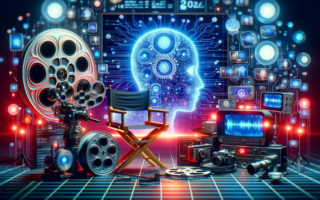In 2024, technology continues to play a pivotal role in shaping the industry. One of the most significant technological advancements that has been making waves in recent years is Artificial Intelligence (AI).
AI is not just a buzzword; it is transforming the way films are created, and it’s redefining the role of film directors in 2024.
The art of filmmaking has traditionally been a highly creative and collaborative process, with the director serving as the visionary leader who brings a story to life on the screen.
However, with the advent of AI technologies, this role is undergoing a fundamental transformation.
In this blog post, we will explore how AI is redefining the role of film directors in 2024 and its implications for the future of the film industry.
AI in Pre-Production
1. Script Analysis
One of the initial stages of filmmaking is script analysis. Traditionally, directors rely on their instincts and experiences to evaluate scripts and make creative decisions.
However, AI-powered tools can now assist directors in this process. AI algorithms can analyze scripts to identify potential flaws, predict audience reactions, and even suggest improvements. This allows directors to make more informed decisions about which projects to pursue and how to enhance the script for maximum impact.
2. Casting Suggestions
Casting is a critical aspect of filmmaking, as the choice of actors can significantly impact the overall success and reception of a film.
In the context of how AI is redefining the role of film directors in 2024, let’s dive deeper into how AI can assist directors in making casting suggestions:
Analyzing Character Descriptions
When directors receive a script, they typically have character descriptions that outline the personalities, physical traits, and backgrounds of each character. AI can analyze these character descriptions and provide recommendations for actors who match the criteria. This analysis goes beyond simple keyword matching and delves into nuanced aspects, such as emotional range, acting style, and chemistry with potential co-stars.
Predicting Audience Preferences
AI can tap into vast databases of audience preferences, historical box office data, and demographic information to predict which actors are likely to resonate with the target audience. By understanding the audience’s preferences, AI can suggest casting choices that align with the film’s genre and target demographic, increasing the film’s appeal and commercial success.
Assessing Actor Availability
Casting decisions are often influenced by an actor’s availability and scheduling conflicts. AI can analyze the schedules of potential actors and identify their availability for the film’s shooting dates. This helps directors make informed decisions while considering logistical constraints.
Diversity and Inclusion
AI can assist directors in ensuring diversity and inclusion in casting choices. By analyzing scripts and providing recommendations, AI can help directors consider a broader range of actors from various backgrounds, ensuring that the film reflects a more inclusive and representative world.
Analyzing Acting History
AI can analyze the acting history and past performances of potential actors. By examining an actor’s filmography, awards, and critical reviews, AI can offer insights into their acting skills, versatility, and suitability for specific roles. This historical analysis can guide directors in making informed decisions about casting choices.
Chemistry and Compatibility
Chemistry between actors is crucial, especially in films with romantic or dynamic relationships between characters. AI can analyze the past collaborations and on-screen chemistry between potential co-stars, providing directors with insights into how well they might work together.
Cost Estimation
Budget considerations play a significant role in casting decisions. AI can provide estimates of actors’ salary ranges based on their previous projects, market demand, and popularity. This helps directors make informed decisions while staying within budget constraints.
Customized Suggestions
AI-powered casting tools are often customizable to the director’s preferences. Directors can input their creative vision and specific criteria for each character, and the AI system can generate casting suggestions tailored to those preferences.
Reducing Bias
AI can help reduce bias in casting decisions by focusing on objective criteria and data-driven insights rather than subjective judgments. This can lead to more inclusive and equitable casting choices.
Streamlining the Casting Process
Overall, AI streamlines the casting process by providing directors with a wealth of data and insights, saving time and effort in the decision-making process. While the final casting decisions ultimately rest with the director, AI serves as a valuable tool to enhance the casting process and ensure that the chosen actors align with the film’s goals and audience expectations.
AI’s role in casting suggestions goes beyond mere automation; it leverages data analysis and predictive capabilities to provide directors with a comprehensive understanding of potential actors and their suitability for specific roles.
This empowers directors to make more informed and strategic casting decisions, ultimately contributing to the success of their films.
AI in Production
Shot Composition
During the filming process, directors work closely with cinematographers to achieve the desired shot compositions. AI can now assist in this aspect by analyzing the script, scene requirements, and visual aesthetics to suggest optimal camera angles, lighting setups, and even the placement of actors. This not only saves time but also enhances the overall visual quality of the film.
Real-time Feedback
AI can provide real-time feedback to directors and cinematographers on set. Facial recognition technology can analyze actors’ expressions and provide insights into their performances, helping directors capture the perfect emotion for a scene. Additionally, AI can monitor technical aspects such as focus, exposure, and color grading, ensuring that every shot meets the desired standards.
AI in Post-Production
Editing and Post-Production
Editing is a critical phase in filmmaking, where directors shape the narrative and pacing of the film. AI-powered editing tools can analyze hours of footage, identify the best takes, and even suggest editing techniques based on established cinematic principles.
This accelerates the post-production process and allows directors to focus on the creative aspects of storytelling.
Sound Design
Sound plays a vital role in creating an immersive cinematic experience. AI can analyze the film’s genre, mood, and audience preferences to generate music and sound effects that enhance the emotional impact of each scene. Directors can fine-tune these AI-generated soundtracks to align with their vision, saving both time and resources.
AI in Decision-Making
Data-Driven Decisions
AI provides directors with access to vast amounts of data and analytics that can inform key decisions. From audience demographics to box office trends, AI can offer valuable insights that guide marketing strategies, distribution plans, and even future project choices. Directors can make informed decisions based on data, reducing the risk associated with filmmaking.
The Human Touch
While AI is undeniably reshaping the filmmaking landscape, it’s essential to emphasize that it does not replace the role of the film director. Instead, it enhances their capabilities, offering valuable tools and insights that aid in decision-making and creative processes.
The human touch, creativity, and intuition that directors bring to their projects remain irreplaceable.
Challenges and Ethical Considerations
As AI becomes more integrated into filmmaking, several challenges and ethical considerations arise. These include:
Job Displacement
Job displacement, in the context of the film industry, refers to the potential loss of employment opportunities for human workers in various roles due to the automation and use of AI technologies. As AI technology evolves and becomes more sophisticated, it can take over tasks and functions that were traditionally performed by human crew members, leading to concerns about job security and the impact on the film industry’s workforce.
Roles Vulnerable to Displacement
- Data Analysis and Research: AI can quickly analyze vast amounts of data, including audience preferences, market trends, and historical box office data. This can reduce the need for data analysts and researchers who previously provided such insights to filmmakers.
- Script Analysis: AI-powered tools can analyze scripts, identify potential flaws, and even suggest improvements. While directors still make the final decisions, script analysts or consultants may find their roles diminished.
- Casting Assistants: AI can provide casting suggestions based on script analysis, audience data, and historical actor performance data. Casting assistants may see their roles shifting from suggesting actors to managing the logistics of casting.
- Technical Crew: AI can monitor technical aspects of filmmaking, such as focus, exposure, and color grading, during shooting. This can reduce the need for some technical crew members, like focus pullers or colorists.
- Editing Assistants: AI-powered editing tools can suggest edits, identify best takes, and automate certain aspects of the editing process. While editors will still play a crucial role, editing assistants may find themselves taking on different responsibilities.
- Sound Engineers: AI can generate music and sound effects based on the film’s genre and mood. Sound engineers may need to adapt their roles to focus on refining and customizing AI-generated soundtracks.
- Crew in Repetitive Tasks: AI-powered robots and drones can handle repetitive tasks like camera movement, reducing the need for crew members in those roles.
Mitigating Job Displacement
While job displacement is a legitimate concern, there are strategies and approaches that the film industry can adopt to mitigate its impact:
- Reskilling and Upskilling: Encourage current crew members to acquire new skills in AI-related fields, such as data analysis, AI programming, and AI tool operation. This can make them more valuable in the evolving industry.
- Hybrid Roles: Create hybrid roles that combine AI expertise with traditional film industry skills. For example, a “Data-Driven Script Consultant” could bridge the gap between AI-generated script analysis and directorial decisions.
- Creative Oversight: Maintain human involvement in creative decision-making processes. While AI can provide suggestions and insights, it should not replace the director’s or producer’s final creative control.
- Ethical AI Use: Ensure that AI systems are used ethically and responsibly. This includes addressing bias in AI algorithms and respecting data privacy rights.
- Job Transition Programs: Establish job transition programs or incentives to help displaced workers transition to new roles within or outside the film industry.
- Collaboration: Encourage collaboration between AI developers, filmmakers, and industry professionals to ensure that AI technologies are designed with the industry’s specific needs and values in mind.
- Public Policy: Advocate for public policies that support the workforce in adapting to technological changes, such as workforce training programs and unemployment benefits.
Job displacement is a concern in the film industry as AI and automation technologies continue to evolve.
However, with proactive measures and a balanced approach that combines AI’s capabilities with human creativity and oversight, the industry can navigate these changes while still providing opportunities for its workforce to adapt and thrive in the evolving landscape of filmmaking in 2024 and beyond.
Creative Control
Directors must balance the use of AI tools with their creative control over the final product. While AI can provide valuable suggestions, directors must ensure that their artistic vision remains at the forefront of the filmmaking process.
Data Privacy
AI relies on data, including personal information, to make informed decisions. Protecting the privacy and consent of individuals involved in the filmmaking process is essential to avoid ethical and legal issues.
Conclusion
In 2024, AI is not merely a novelty in the world of film; it is a powerful tool that is redefining the role of film directors.
From script analysis to post-production, AI assists directors in making informed decisions, improving efficiency, and enhancing the overall quality of films.
However, while AI offers numerous benefits, it also poses challenges and ethical considerations that the film industry must address.
Ultimately, the fusion of human creativity and AI technology has the potential to elevate the art of filmmaking to new heights, offering exciting opportunities for directors and audiences alike.


